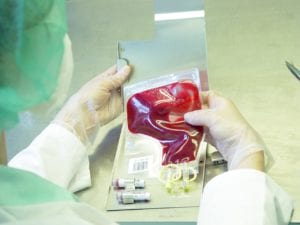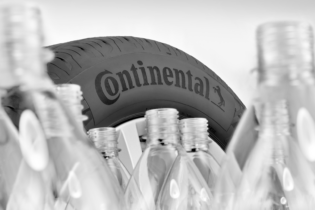Identifying opportunities for hazardous waste minimisation
Waste minimisation is more important than recycling, in particular with regard to hazardous waste. The study below looks at a waste minimisation plan at the medical and chemical engineering schools at the University of KwaZulu-Natal. AbstractThe purpose of this paper is to present results of a preliminary investigation into implementing a hazardous waste minimisation plan at the University of KwaZulu-Natal (UKZN), using medical and chemical engineering and schools as case studies. The status quo of the waste system at both schools was established by interviewing relevant university staff. A waste minimisation plan was then proposed based on the interview results and waste minimisation plans in operation at local and international universities. A survey was then carried out to assess students’ current waste management behaviour and their willingness to participate in the implementation of the proposed plan. The results of the survey showed that at least 72% of the students understood that waste minimisation was more important than recycling. Also, more than 90% of the students were willing to participate in the implementation of the proposed waste minimization plan if more information on waste minimisation was provided. Introduction
At the moment, UKZN does not have a waste minimisation plan for any of the three main waste categories: hazardous, general and inert. Hazardous waste means “any waste that contains organic or inorganic elements or compounds that may, owing to inherent physical, chemical or toxicological characteristics of that waste, have a detrimental impact on health and the environment” (Republic of South Africa, 2008). Due to the nature of hazardous waste, it “cannot be released into the environment or be added to sewage or be stored in a situation which is either open to air or from which aqueous leachate could emanate” (Department of Environmental Affairs and Tourism, 2008). This preceding point underscores the need for reduction of the amount of hazardous waste that is generated at UKZN, hence the purpose of this preliminary investigation. Waste minimisation, on the other hand, is defined as “any activity that is undertaken by the generator of waste to prevent or reduce the volume and/or environmental impact of waste that is generated, treated, stored or disposed of” (Department of Environmental Affairs and Tourism, 2000). This definition has now been incorporated into the National Environmental Management: Waste Act, 2008 (Act 59 of 2008) albeit in a slightly revised form (Republic of South Africa, 2008). In terms of the waste minimization scheme, the main goal will be to reduce the volume of the waste generated and also reduce its environmental impact or toxicity. Due to the fact that hazardous waste has many streams, the waste minimization scheme will focus on chemical and bio-hazardous waste. The scheme is based primarily on schemes that are in operation at international universities such as the University of Miami and the University of California – Santa Barbara, and locally, the University of Stellenbosch. Methodology
The objectives of the preliminary investigation were three-fold: to determine the status-quo for hazardous waste management UKZN using case study schools; develop a plan and to identify the opportunities for waste minimisation and; to assess the willingness of students to engage in hazardous waste minimisation. This section outlines the process that was followed in carrying out the investigation. In order to establish the status quo of hazardous waste management practice at the chemical engineering and medical schools, staff members responsible for hazardous waste management were interviewed. The main information requested was the types of waste generated, the volumes / amounts for each stream, and how each stream was being managed – classification and storage of the generated waste and ultimately, the disposal of the waste. A literature review was conducted on the waste minimisation schemes operational in other universities. The outcomes of the interviews were then compared with the outcome of the literature review, from which a waste minimisation plan for the case study schools was then proposed. Following the proposal of a waste minimisation plan, a survey was conducted at both schools to determine the basic understanding of students with regard to hazardous waste management and also to determine the willingness of the students to participate in and to promote the waste minimization scheme. Since not all the students could be surveyed, a representative sample was determined for each school using statistical methods. The sample size for each school was determined using Equation 1 as a basis. However, the actual sample size was calculated using readily available sample size calculators on the internet (Survey Systems, 2009); which take into account the population size of each school. A self-administered questionnaire was applied in both areas using convenience sampling given the fact that this was a preliminary investigation. The results were then analysed using Microsoft Excel. The results from the staff interviews and the student survey were then used to gauge whether there was sufficient scope and opportunities for the implementation of separate hazardous waste minimization schemes in both schools. These results are presented in the next section. where: n = sample size
p = value used to represent the population proportion
e = desired margin of error
z = critical value from the standard normal table Results
Status quo
In the medical school, the interviews yielded the following results:
• Purchasing of chemicals is done by the user who has to follow a procedure set up by the Procurement Department: Users can only purchase the chemicals once approval has been given by the Procurement Department. This process eliminates the scenario of users just randomly purchasing chemicals and allows the Procurement Department to keep track of the chemicals purchased and to manage funds for this process appropriately.
• Storage facilities for the waste are based on safety aspects that take into consideration the incompatibility of certain chemicals. For example, separate storage facilities are provided for chlorinated and non-chlorinated waste. The onus is on the waste producer to decant their waste into appropriate drums.
• Hazardous waste is separated into chemical and bio-hazardous streams. The chemical waste is then separated into chlorinated and non-chlorinated waste. Bio-hazardous waste is separated into solid waste, sharps, human tissue and pharmaceuticals. Both major streams of waste are collected as the need arises and disposed of by specialist contractors using appropriate disposal methods for each waste stream.
• the only problem with the present system is that the volumes or quantities of waste generated are not measured and recorded, or where the information is available, it is considered confidential. As a result, it is not clear how much waste is being generated and how much is being disposed of. In the chemical engineering school, the LCA yielded the following results:
• Purchasing of chemicals is done by the School and most of the chemicals are brought from or through the same company. A similar purchasing procedure to the one in Medical School is followed.
• Similar to medical school, separate storage facilities are provided, but this time for solvents and dry chemicals. Also, acids and bases are stored in the same room as the solvents, but in a clearly segregated section of the store room. It is important to note that a completely separate storage room for acids and bases is being constructed at the moment.
• The generated waste is separated into chlorinated and non-chlorinated solvents and various redundant chemicals. After classification, the storage drums are clearly marked, but the onus still remains on the waste generator to dispose of their waste in the appropriate drum. Collection and disposal of the waste is done by an appointed contractor, with collection taking place when the need arises and disposal taking place at an appropriate disposal facility.
• Similar to medical school, there is no record keeping for the volumes/quantities of waste produced and disposed of. Waste minimisation plan
The waste minimisation plan is based on international bests practice and involves three main steps:
• the classification of the generated waste
• the reduction of the volume of waste generated
• the reduction in the toxicity of the generated waste.
Classification will be carried out using the present method of identifying characteristics as set out in SANS 10228. Source reduction will utilise an effective purchasing strategy, where chemicals are procured for specific purposes rather than buying in bulk for an extended period. When the chemicals are being used, good housing keeping methods will be adopted to reduce the volume of waste generated. For example, hazardous and non-hazardous waste will be kept separate so that there is no contamination of non-hazardous waste, which would increase the volume of hazardous waste needing disposal. Recycling of the waste could take place through re-distillation of solvents, where possible, and chemical exchange programmes for generated waste. The latter is already happening in industry; hence it can be scaled down to fit a university setting. For reducing toxicity of the waste, chemical substitution should be utilised. Chemical substitution is a strategy where current chemicals used in projects and practicals are replaced less toxic ones. For example, Acetamide can be substituted with Stearic acid for freezing point depression or Formaldehyde can be substituted with Ethanol for specimen storage (Florida Atlantic University, 2002). The success of such a plan depends on the corporation and participation of staff and students respectively. The next section will focus on the results of the survey to determine the basic understanding of students with regard to hazardous waste management and their willingness to participate in the proposed plan.
Student survey
Using Equation 1 and population sizes of 1 500 for the medical school and 386 for chemical engineering, the sample sizes were calculated as 173 and 130 students respectively. For both schools, p = 0.5, which maximised the sample size and a 7% margin of error at 95% level of confidence were used. Due to the timing of the survey, final year students in both schools were not interviewed, so the results are representative of lower levels of the Undergraduate programme students in both Schools.
What approach is the best way to reduce the amount of hazardous waste produced? Recycle Re-use Prevention Total
Medical 22 2 76 100
Chemical 26 2 72 100
Is it safe to discard chemicals down the drain? Yes No Total
Medical 1 99 100
Chemical 4 96 100
Were you taught about the impacts of waste in 1st year? Yes No Total
Medical 86 14 100
Chemical 63 37 100
How often do you produce hazardous waste in lab sessions? Daily Weekly Monthly Total
Medical 27 52 21 100
Chemical 38 43 19 100 Table 2: Descriptive statistics for students’ willingness to participate in waste minimisation Issue School Response (%)
Waste minimisation currently implemented at UKZN? Yes No Unsure Total
Medical 24 1 75 100
Chemical 29 2 69 100
Willing to participate in hazardous waste minimisation? Yes No Total
Medical 91 9 100
Chemical 79 21 100
Do you need more info about waste min. before participating? Yes No Total
Medical 98 2 100
Chemical 92 8 100 It can be seen from Table 2 that at least 69% of the students are not sure whether waste minimisation is being implemented at UKZN. Despite this uncertainty, most of the students in the medical school (91%) and the chemical engineering school (79%) are willing to participate in waste minimisation. The lower waste minimisation willingness rate for chemical engineering could be attributed to the fact that fewer students in the school, compared with medical school, were taught about the impacts of hazardous waste in their first year of study as shown in Table 1. This difference in knowledge may not be critical given the fact that more than 90% of students in both Schools still require more information about waste minimisation before they can participate in it. Discussion and conclusion
In this section, the information presented in the results section will be evaluated with the aim of categorising it as an opportunity or challenge for implementing hazardous waste minimisation at the two schools. The evaluation will focus on the current hazardous waste management system in terms of the processes being used and the perceptions of the primary waste generators – the students. Conclusions will then be drawn on the research based on the evaluation process. The fact that protocols are followed in the purchasing of chemicals in both Schools presents an opportunity for waste minimisation as the process allows tracking of the types of chemicals that have been purchased by the schools. This information is important in that chemical substitution can then be implemented where feasible and thus reduces the toxicity of the waste generated. However, chemical substitution can only take place when both the types of chemicals and their quantities are known. The latter presents a challenge given that the purchasing department does not keep track of the quantities of chemicals purchased since order forms and disposal forms are not kept for long – there is no data base or file where the forms are kept. This challenge will need to be overcome if implementation of the waste minimisation plan is to become a reality. A possible solution would be to set up a database, housing information on the amount of hazardous waste that is generated and then analysing the effectiveness of waste minimisation measures in reducing waste quantities needing disposal. Setting up the data base is a challenge because of the inefficient way of keeping records that could be used for comparison. The separated storage of waste also presents an opportunity for waste minimisation since segregation of waste reduces the risk of hazardous waste contaminating general waste. Also, segregation of the hazardous waste itself is an opportunity for waste minimisation, given that the separated waste could be used in a chemical exchange programme with other schools. The lack of waste data, however, is a challenge, since quantities of generated waste will need to be known in order to make the chemical exchange programme feasible. This point underscores the need for a waste database in both schools. Another opportunity for waste minimisation is presented by the willingness of the students to implement the waste minimisation plan. This result is very important given that the students are the primary generators of waste and are therefore responsible for disposing of the waste in the correct receptacles. With the students practicing source separation, the benefits mentioned previously will be realised. However, if the students were not willing to separate their waste at source, the benefits of reduced contamination and possibility of engaging in chemical exchange programmes would not take place. Thus it is imperative that the students are provided with the information that they require in order for them to participate in waste minimisation activities. In conclusion, the research presented in this paper has shown that there are opportunities for implementing hazardous waste minimisation at the medical and chemical engineering schools at UKZN. The proposed waste minimisation plan is based on international best practice and incorporates waste reduction and recycling along with reduction in toxicity of the generated waste. It has been shown that present waste management methods employed in both schools could be transformed waste minimisation schemes. But more importantly, the primary generators of waste, who are the students, are willing to participate in waste minimisation if they are provided with information that shows them how. by N Matete* and R Mahomed *University of KwaZulu-Natal, Civil Engineering Programme, School of Civil Engineering, Surveying and Construction, Durban, KwaZulu-Natal, South Africa








